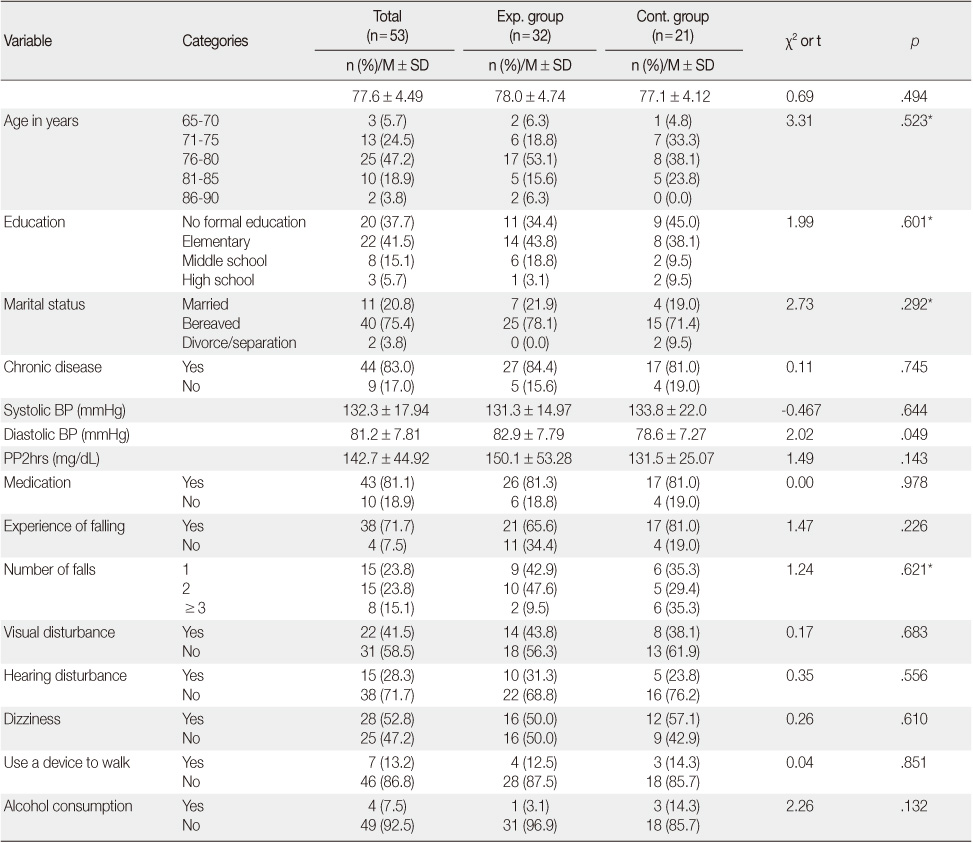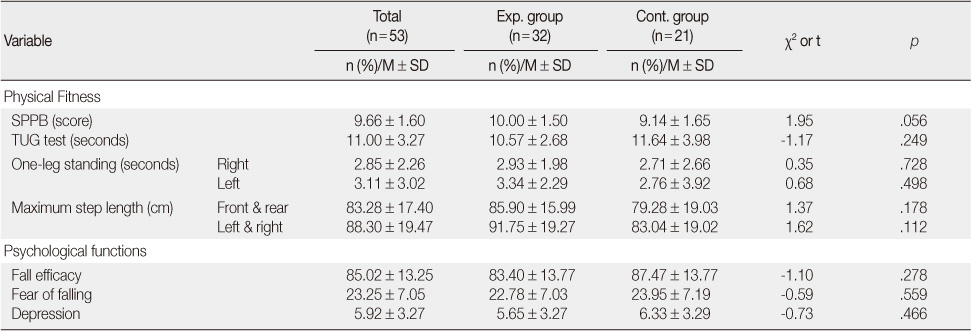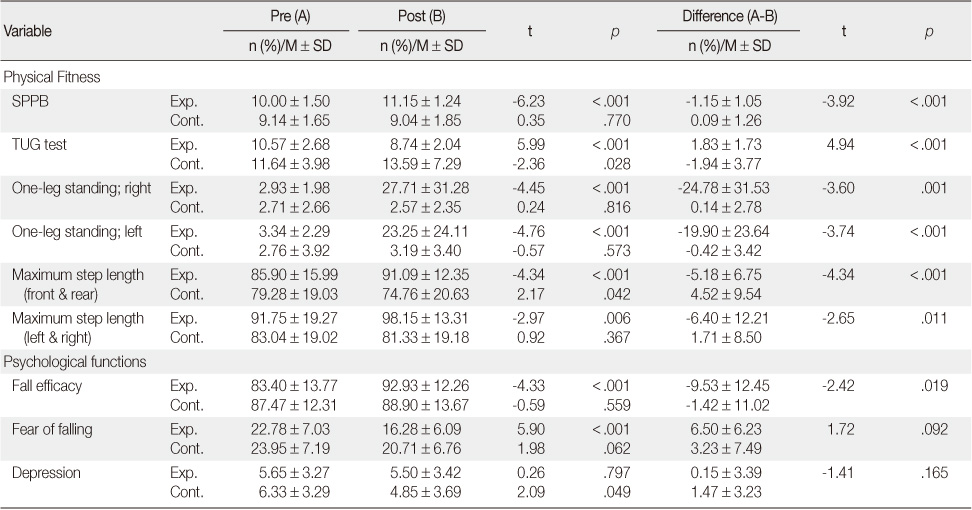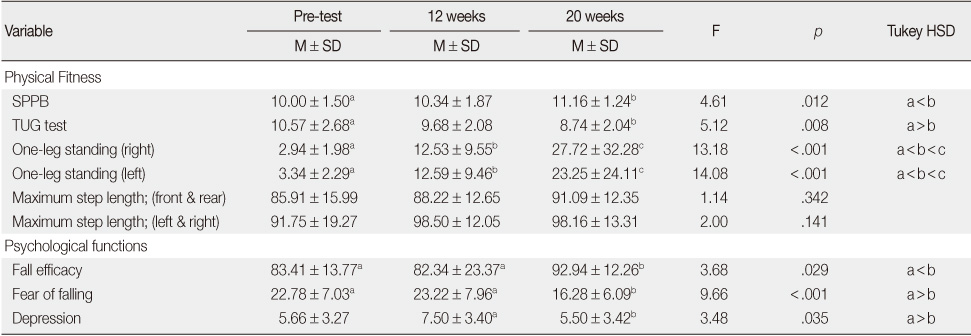Articles
- Page Path
- HOME > J Korean Acad Nurs > Volume 41(2); 2011 > Article
-
Original Article
- Effects of a Fall Prevention Program on Physical Fitness and Psychological Functions in Community Dwelling Elders
- Myung Soon Kwon
-
Journal of Korean Academy of Nursing 2011;41(2):165-174.
DOI: https://doi.org/10.4040/jkan.2011.41.2.165
Published online: April 30, 2011
Associate Professor, Department of Nursing, Hallym University, Chuncheon, Korea.
- Address reprint requests to: Kwon, Myung Soon. Department of Nursing, Hallym University, 39 Hallimdaehak-gil, Chuncheon 200-702, Korea. Tel: +82-33-248-2719, Fax: +82-33-248-2734, kwon1314@hallym.ac.kr
© 2011 Korean Society of Nursing Science
Abstract
-
Purpose
- This study was done to identify effects of a fall prevention program on physical fitness and psychological functions in community dwelling elders.
-
Methods
- A quasi-experimental study was carried out with a nonequivalent control group pre & post-test design. The program, which included exercises and education, consisted of a 12-week group program and an 8-week self-management program using a health calendar. An experimental group (32) and a control group (21) participated.
-
Results
- There were significant differences in SPPB (t=-3.92, p<.001), TUG test (t=4.94, p<.001), standing with right leg (t=-3.60, p=.001), standing with left leg (t=-3.74, p<.001), front and rear maximum step length test (t=-4.34, p<.001), right-left maximum step length test (t=-2.65, p=.011), and fall efficacy (t=-2.42, p=.019). Fall efficacy, fear of falling and depression showed significant differences following the 12-week exercise program and 8-week self-management program in the experimental group.
-
Conclusion
- Study findings indicate that the fall prevention program is an effective nursing intervention to enhance physical fitness and psychological functions for elders. Using a health calendar, the self-management program was more effective for psychological functions compared to only the group program. Therefore, health providers should develop diversified fall prevention programs which include motivation plans to encourage clients in participating.
This research was supported by Basic Science Research Program through the National Research Foundation of Korea (NRF) funded by the Ministry of Education, Science and Technology (2009-0068282).
- 1. Akyol AD. Fall in the elderly: What can be done? International Nursing Review. 2007;54:191–196.ArticlePubMed
- 2. Choi JH. The effects of Tai Chi exercise on physiologic, psychological functions, and fall in fall prone elderly. 2002;Seoul, The Catholic University of Korea. Unpublished doctoral dissertation.
- 3. Choi JH, Moon JS, Sohng KY. The effects of Tai Chi exercise on physiologic, psychological functions, and falls among fall prone elderly. Journal of Rheumatology Health. 2003;10:62–76.
- 4. Clemson L, Cumming RG, Kendig H, Swann M, Heard R, Taylor K. The effectiveness of a community-based program for reducing the incidence of falls in the elderly: A randomized trial. Journal of the American Geriatrics Society. 2004;52:1487–1494.ArticlePubMed
- 5. Elley CR, Robertson MC, Garrett S, Kerse NM, Mckinlay E, Lawton B, et al. Effectiveness of falls-and-fracture nurse coordinator to reduce falls: A randomized controlled trial of at-risk older adults. Journal of the American Geriatrics Society. 2008;56:1383–1389.PubMed
- 6. Feibel JH, Springer CJ. Depression and failure to resume social activities after stroke. Archives of Physical Medicine and Rehabilitation. 1982;63:276–277.PubMed
- 7. Gu MO, Jeon MY, Kim HJ, Eun Y. A review of exercise interventions for fall prevention in the elderly. Journal of Korean Academy of Nursing. 2005;35:1101–1112.ArticlePubMedPDF
- 8. Guralnik JM, Ferrucci L, Simonsick EM, Salive ME, Wallace RB. Lower-extremity performance in persons over the age of 70 years as a predictor of subsequent disability. The New England Journal of Medicine. 1995;332:556–561.PubMedPMC
- 9. Hornbrook MC, Stevens VJ, Wingfield DJ, Hollis JF, Greenlick MR, Ory MG. Preventing falls among community-dwelling older persons: Results from a randomized trial. The Gerontologist. 1994;34:16–23.ArticlePubMed
- 10. Jeon MY, Bark ES, Lee EG, Im JS, Jeong BS, Choe ES. The effects of a Korea traditional dance movement program in elderly women. Journal of Korean Academy of Nursing. 2005;35:1268–1276.PubMed
- 11. Jung YM, Lee SE, Chung KS. Prevalence and associated factors of falls according to health status in elderly living in the community. Journal of the Korean Gerontological Society. 2006;26:291–303.
- 12. 2005 Korean health and nutrition examination survey. Korea Centers for Disease Control and Prevention. 2006, December; Seoul, Author.
- 13. Liu MR, So HY. Effects of Tai Chi exercise program on physical fitness, fall related perception and health status in institutionalized elders. Journal of Korean Academy of Nursing. 2008;38:620–628.ArticlePubMed
- 14. Mahoney JE, Shea TA, Przybelski R, Jaros L, Gangnon R, Cech S, et al. Kenosha county falls prevention study: A randomized, controlled trial of an intermediate-intensity, community-based multifactorial falls intervention. Journal of the American Geriatrics Society. 2007;55:489–498.ArticlePubMed
- 15. Menz HB, Lord SR, Fitzpatrick RC. A structural equation model relating impaired sensorimotor function, fear of falling and gait patterns in older people. Gait posture. 2006;25:243–249.ArticlePubMed
- 16. Nelson ME, Layne JE, Bernstein MJ, Nuernberger A, Castaneda C, Kaliton D, et al. The effects of multidimensional home-based exercise on functional performance in elderly people. The Journals of Gerontology. Series A, Biological Sciences and Medical Sciences. 2004;59:154–160.PubMed
- 17. Park EY. The effects of mixed exercise program on physical fitness and depression in the elderly. 2005;Seoul, Ewha Womans University. Unpublished doctoral dissertation.
- 18. Park SK. The effects of falls prevention exercise on functional fitness in elderly. 2008;Seoul, Kyunghee University. Unpublished master's thesis.
- 19. Rejeski WJ, King AC, Katula JA, Kritchevsky S, Miller ME, Walkup MP, et al. Physical activity in prefrail older adults: Confidence and satisfaction related to physical function. The Journals of Gerontology. Series B, Psychological Sciences and Social Sciences. 2008;61:19–26.
- 20. Ryeom TH, Kim SY, So YK, Park SY, Lee JH, Cho HS, et al. The risk factors of falls in the elderly. Journal of the Korean Academy of Family Medicine. 2001;22:221–229.
- 21. Salminen MJ, Vahlberg TJ, Salonoja MT, Aarnio PT, Kivela SL. Effect of a risk-based multifactorial fall prevention program on the incidence of falls. Journal of the American Geriatrics Society. 2009;57:612–619.ArticlePubMed
- 22. Scott VJ, Votova K, Gallagher E. Falls prevention training for community health workers: Strategies and actions for independent living(SAIL). Journal of Gerontological Nursing. 2006;32:48–56.Article
- 23. Sheikh JI, Yesavage JA. Geriatric depression scale (GDS), recent evidence and development of a shorter version. Clinical Gerontologist. 1986;5:165–173.Article
- 24. Shin KR, Shin SJ, Kim JS, Kim JY. The effects of fall prevention program on knowledge, self-efficacy, and preventive activity related to fall, and depression of low-income elderly women. Journal of Korean Academy of Nursing. 2005;35:104–112.ArticlePubMedPDF
- 25. Shumway-Cook A, Silver IF, LeMier M, York S, Cummings P, Koepsell TD. Effectiveness of a community-based multifactorial intervention on falls and fall risk factors in community-living older adults: A randomized controlled trial. The Journals of Gerontology. Series A, Biological Sciences and Medical Sciences. 2007;62:1420–1427.ArticlePubMed
- 26. Tideiksaar R. Falling in old age-prevention and management. 1997;2nd ed. New York, Spring Publishing Co.
- 27. Tinetti ME, Richman D, Powell L. Fall efficacy as a measure of fear of falling. Journal of Gerontology. 1990;45:P239–P243.ArticlePubMed
- 28. Yoo IY. Effects of fall prevention program applying HSEP on physical balance and gait, leg strength, fear of falling and falls efficacy of community-dwelling elderly. Journal of the Korean Gerontological Society. 2009;29:259–273.
REFERENCES
Figure & Data
REFERENCES
Citations

- Effects of a fall prevention exercise regimen on physical and psychosocial outcomes in elderly community dwellers: a randomized comparative study
Ji-Yeon Sim, Jung-Wan Koo, Yeon-Gyu Jeong
Physiotherapy Theory and Practice.2025; 41(2): 252. CrossRef - Effectiveness of exercise prescription variables to reduce fall risk among older adults: a meta-analysis
Tian-Rui Zhu, Hong-Qi Xu, Jin-Peng Wei, He-Long Quan, Xue-Jiao Han, Tian-Xiang Li, Ji-Peng Shi
European Review of Aging and Physical Activity.2025;[Epub] CrossRef - Effects of Fall Prevention Elastic Band Exercise on Physical Function Test, Grasp Power, Flexibility, and Muscle Volume in Older Women
Young-Eun Song
Journal of Korean Association of Physical Education and Sport for Girls and Women.2023; 37(1): 37. CrossRef - Cognitive behavioural therapy (CBT) with and without exercise to reduce fear of falling in older people living in the community
Eric Lenouvel, Phoebe Ullrich, Waldemar Siemens, Dhayana Dallmeier, Michael Denkinger, Gunver Kienle, G A Rixt Zijlstra, Klaus Hauer, Stefan Klöppel
Cochrane Database of Systematic Reviews.2023;[Epub] CrossRef - Effects of a Stim up Mat Walking Exercise Program on Balance, Gait Function and Joint Motion Range of the Frail Elderly
Gyeong Ran Kim, Mi Sook Song
Journal of Korean Academy of Community Health Nursing.2019; 30(1): 47. CrossRef - Effect of Strength Exercise on Patient Fall Prevention Program: Focusing on the Fall High Risk Group Elderly Patients
Hyun-Ok Lee, Byung-Hwa Lee, Chang-Hee Lee
Journal of Health Informatics and Statistics.2017; 42(4): 338. CrossRef - Effects of elastic-band resistance exercise on balance, mobility and gait function, flexibility and fall efficacy in elderly people
Cheol-Jin Kwak, You Lim Kim, Suk Min Lee
Journal of Physical Therapy Science.2016; 28(11): 3189. CrossRef - The Effect of a Comprehensive Intervention Program on the Functional Status and Bone Density of the Socially-Vulnerable and Frail Elderly
In Sook Lee, Kwang Ok Lee
Journal of Korean Academy of Community Health Nursing.2016; 27(1): 51. CrossRef - Effect of Tai-Chi on Grip Power, Pain and Fear of Falling in Elderly Person
Chung-uk Oh
Journal of the Korea Academia-Industrial cooperation Society.2016; 17(5): 631. CrossRef - Effects of a Thera-Band Exercise Program on Pain, Knee Flexion ROM, and Psychological Parameters Following Total Knee Arthroplasty
Ji Yeong Yun, Jong Kyung Lee
Journal of Korean Academy of Nursing.2015; 45(6): 823. CrossRef - Strategies on fall prevention for older people living in the community: A report from a round-table meeting in IAGG 2013
Eun Joo Kim, Hidenori Arai, Piu Chan, Liang-Kung Chen, Keith D. Hill, Bernard Kong, Philip Poi, Maw Pin Tan, Hyung Joon Yoo, Chang Won Won
Journal of Clinical Gerontology and Geriatrics.2015; 6(2): 39. CrossRef - Fall Risk in the Community-dwelling Elderly who Received Home Care Services: Focused on Residential Environment and Perception of Fall Risk
Chong Mi Lee, Bok-Hee Cho
Journal of muscle and joint health.2014; 21(1): 36. CrossRef - Exercise for reducing fear of falling in older people living in the community
Denise Kendrick, Arun Kumar, Hannah Carpenter, G A Rixt Zijlstra, Dawn A Skelton, Juliette R Cook, Zoe Stevens, Carolyn M Belcher, Deborah Haworth, Sheena J Gawler, Heather Gage, Tahir Masud, Ann Bowling, Mirilee Pearl, Richard W Morris, Steve Iliffe, Kim
Cochrane Database of Systematic Reviews.2014;[Epub] CrossRef - Effects of Community-based Comprehensive Fall Prevention Program on Muscle Strength, Postural Balance and Fall Efficacy in Elderly People
Jeongyee Bae, Seong-il Cho
Journal of Korean Academy of Nursing.2014; 44(6): 697. CrossRef - Effects of a Randomized Controlled Recurrent Fall Prevention Program on Risk Factors for Falls in Frail Elderly Living at Home in Rural Communities
JongEun Yim
Medical Science Monitor.2014; 20: 2283. CrossRef - Fall Experience and Risk Factors for Falls among the Community-dwelling Elderly
Young Hee Kim, Kyung Hee Yang, Kum Sook Park
Journal of muscle and joint health.2013; 20(2): 91. CrossRef - Risk Factors for Recurrent Falls Among Community-dwelling Elderly in Rural Areas
Mi-Yang Jeon, Sun Hee Yang
Journal of the Korea Academia-Industrial cooperation Society.2013; 14(12): 6353. CrossRef - Factors Associated with Nurses' Activities for Hospital Fall Prevention
In Kyoung Lee, Ja Yun Choi
The Korean Journal of Rehabilitation Nursing.2013; 16(1): 55. CrossRef - Effects of a Fall Prevention Program on Falls in Frail Elders Living at Home in Rural Communities
Jae-Soon Yoo, Mi Yang Jeon, Chul-Gyu Kim
Journal of Korean Academy of Nursing.2013; 43(5): 613. CrossRef - Effects of a Fall Prevention Program on Physical Functions and Psychological Functions in Rural Elderly Women
Sung-Min Kim, Go-Ya Choi
The Korean Journal of Rehabilitation Nursing.2012; 15(1): 63. CrossRef - Effect of the Tai Chi Fall Prevention Program for Elderly Women Living in the Community
In Sook Park, Hee Young So, Rhayun Song, Hyunli Kim, Sukhee Ahn
Journal of muscle and joint health.2012; 19(3): 282. CrossRef - Effects of a Health Diary Program on Fall-Related Outcomes in Low-Income Elderly Women with Osteoarthritis
Myung-Suk Lee
Journal of agricultural medicine and community health.2011; 36(3): 167. CrossRef
Homogeneity Test for General Characteristics and Health related Characteristics
*Fisher's exact test; Exp.=experimental; Cont.=control; BP=blood pressure; PP2hrs=postprandial blood sugar.
Homogeneity Test for Physical Fitness & Psychological Functions
Exp=experimental; Cont=control; SPPB=short physical performance battery; TUG test=timed up & go test.
Differences of Physical Fitness and Psychological Functions
Pre=pre-test; Post=post-test; Exp=experimental group; Cont=control group; SPPB=short physical performance battery; TUG test=timed up & go test.
Differences of Physical Fitness and Psychological Functions according to Time in the Experimental Group
SPPB=short physical performance battery; TUG test=timed up & go test.
*Fisher's exact test; Exp.=experimental; Cont.=control; BP=blood pressure; PP2hrs=postprandial blood sugar.
Exp=experimental; Cont=control; SPPB=short physical performance battery; TUG test=timed up & go test.
Pre=pre-test; Post=post-test; Exp=experimental group; Cont=control group; SPPB=short physical performance battery; TUG test=timed up & go test.
SPPB=short physical performance battery; TUG test=timed up & go test.
 KSNS
KSNS
 E-SUBMISSION
E-SUBMISSION




 Cite
Cite

